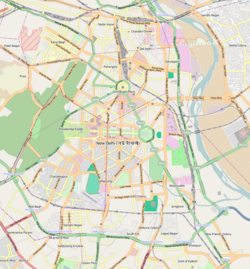
Back बड़ा गुंबद BH বড়া গুম্বদ Bengali/Bangla Complex Bara Gumbad Catalan Bara Gumbad Spanish Бара Ґамбад Ukrainian
| Bara Gumbad | |
|---|---|
 Bara Gumbad at Lodhi Gardens | |
| Religion | |
| Affiliation | Islam |
| Ecclesiastical or organisational status | Historic monument and mosque |
| Ownership | Government of Delhi[clarification needed] |
| Governing body | |
| Status | Active (as a mosque) |
| Location | |
| Location | Lodhi Gardens, Central Delhi, Delhi NCT |
| Country | India |
Location of the monument site in Central Delhi | |
| Geographic coordinates | 28°35′34.4″N 77°13′12.7″E / 28.592889°N 77.220194°E |
| Architecture | |
| Type | Mosque architecture |
| Style | |
| Founder | Sikandar Lodhi (attrib.) |
| Completed |
|
| Specifications | |
| Length | 20 m (66 ft) (Bara Gumbad) |
| Width | 20 m (66 ft) (Bara Gumbad) |
| Interior area |
|
| Height (max) | 29 m (95 ft) (Bara Gumbad) |
| Dome(s) | Multiple |
| Minaret(s) | Two |
| Site area | 1,050 m2 (11,300 sq ft) |
| Materials | Sandstone |
| Official name |
|
| Designated | 9 April 1936 |
| Reference no. | N-DL-73 |
Bara Gumbad (lit. 'big dome') is a medieval monument located in Lodhi Gardens in Delhi, India. It is part of a group of monuments that include a Friday mosque (Jama Masjid) and the "mehman khana" (guest house) of Sikandar Lodhi, the ruler of the Delhi Sultanate. The Bara Gumbad was constructed in 1490 CE, during the reign of the Lodhi dynasty. Its construction is generally attributed to Sikandar Lodhi, and it is believed to have the earliest constructed full dome of any building in Delhi.
The monument is situated near the Tomb of Sikandar Lodhi and Shisha Gumbad. Although the three structures, which share a common raised platform, were all built during the Lodhi reign, they were not constructed at the same time. The intended purpose of the builders of Bara Gumbad is unclear: it may have been intended as a free-standing tomb, but no tombstone has been identified, or as a gateway. The area in which Bara Gumbad is situated was formally called Khairpur village.
Bara Gumbad and the associated mosque are a Monument of National Importance,[1] under the administration of the Archaeological Survey of India.
- ^ "List of Ancient Monuments and Archaeological Sites and Remains of Delhi". Archaeological Survey of India. Retrieved 2 October 2018.
